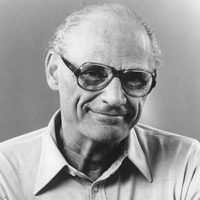Style in Miller's Death of a Salesman
Arthur Miller's style is not free from the influences of those playwrights whose styles were marked by the vigor of experimentation. The play was at first titled as Inside His Head. The title of the play intends to project the inner realism of a psychologically splinted man whose conscious dangles from the north pole of his past to the south pole of his present.

Arthur Miller (1915-2005)
The protagonist of Death of Salesman is in danger of psychological restlessness in extremity. To reinforce this theme Arthur Miller has chosen a sensitive style of recording the psychological state of Willy Loman. The protagonist's psychological equipoise and equilibrium had shattered to the extent of madness. He was all the time in a state of psychological restlessness. Mental peace was alien to him. Normal level of thinking was foreign to him. To engage such a type of almost mad man Miller used that style which takes into account the Voltaire and changeable mood of Willy Loman.
Unlike the language of dialogue in the classical tragedies, the dialogue of Death of a Salesman is in an ordinary language. It had been a convention that the language of tragedy should be poetic and ornamental. It had been a widely applied tradition that characters (protagonist) should converse with other characters in the language of poetry. But Arthur Miller no longer adhered to this convention of tragedy. In his Death of a Salesman almost all the characters, including the protagonist speak in a typical colloquial language. Miller has used a style of linguistic realism. Sometimes they use slang and dialect words also. Moreover, they are also from the working class background. So it won't be matters of wonder if those characters are seen conversing with other characters in their dialect.
Expressionism does not give concrete and photographic realism. It provides essential clues of reality. To provide these clues dramatist often makes use of some devices. In Death of a Salesman also Arthur Miller has made use of these devices. These devices are symbols, music, and flashback. In this play Miller followed the style of using symbols. Music is an important symbol. This music rings louder when the protagonist comes closer to his natural self. The music rings low when he becomes estranged from his self. Apart from this symbol there are other symbols also. The location of Willy Loman's house is itself micro-cosmic of the urban world in which defeated human soul strives to accomplish his/her thwarted ambition and elusive dream.
In the play the protagonist Willy Loman is so depressed and frustrated that he often contemplated suicide. In his suicidal predicament Loman's conscious self was torn between the past and the present. He had no control over his past. Rather, his past used to return to his present in an overwhelmingly dangerous way. He was in a helpless state to retain control over his present. Past brutally invaded the territory of the present. The return of his past can also be taken as the return of the unconscious, the return of nature. To convey this aspect of the protagonist's actual inner realism Arthur Miller adopted the style of blurring the protagonist's past and present. This stylistic feature is directly associated with the main theme of the play.
Death of a Salesman Study Center
Disturbed Gender Relation and Dysfunctional Family in Death of a Salesman
Subversive Nature of Language in Death of a Salesman
The Suicidal Causes of Willy Loman in Death of a Salesman
Death of a Salesman Study Center
Introduction of Death of a Salesman
Summary of Death of a Salesman
Dramatic Technique in Death of a Salesman
Themes of Miller's Death of a Salesman
 |
bachelorandmaster.com |